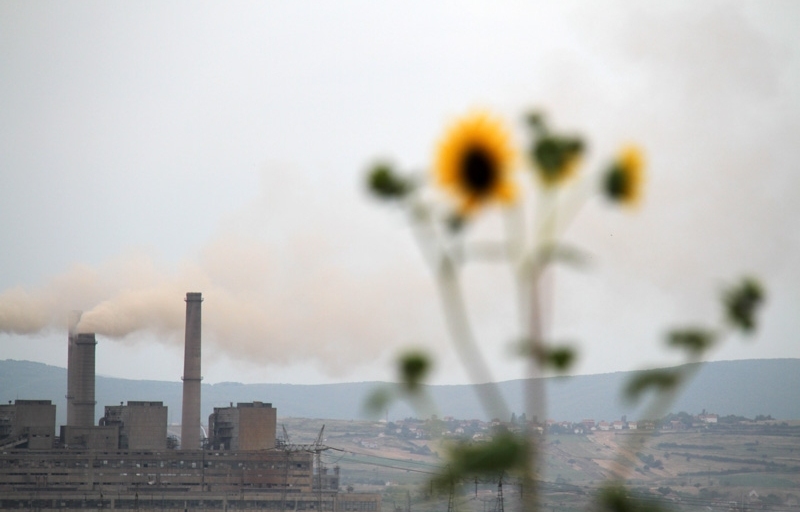29 October 2012
Kosova A Power Plant is becoming a bite hard to swallow, which might even choke and sadden those who will be deciding about its ultimate fate. As concerns this power plant, only its demise by 2017 is allowed to be uttered publicly. Anything else, which could potentially be linked to the possibility of bringing it back to life, is considered a forbidden apple.
On one hand, the international institutions like the World Bank and the EU Office in Kosovo are determined to shut down Power Plant Kosova A until 2017. Furthermore, they have threatened to withdraw the guarantee for the construction of the new power plant “Kosova e Re”. The Government of Kosovo, at least based on the Energy Strategy and public statements, but also as co-signer of the Energy Community Treaty for Southeast Europe, is also determined to shut down TC Kosova A till 2017. As of late, there are attempts in KEK to extend the life of this TC till 2020, at least until new energy capacities are constructed.
Because of continuous delays in the implementation of energy projects on one hand, and the commitment to shut down the existing ones on the other, based on official plans and decisions, Kosovo risks facing an energy collapse. In 2017, the country will be faced with a high lack of energy needs. The shutting down of TC Kosova A, but also the repair of at least one bloc of TC Kosova B in 2018 can be translated in a lack of at least 3375. 5 GW/h electric energy. But, if the annual increase of energy consumption is added to this number, then Kosovo, between 2017-18 could be spending around 120 to 200 million euros for energy import in order to cover the annual needs of the country. In this context, the biggest beneficiaries would be Serb companies, from which Kosovo purchases the lacking energy.
Within this context of being confronted with the problem of sustainable supply with energy, and avoiding spending huge amounts of money in import, an American-Bulgarian consortium has come into play. According to the American-Bulgarian consortium, “Quantum-Risk Engineering LLC (QRE)”, TC Kosova A is not a dinosaur, doomed to perish from history. For this consortium, TC Kosova A presents the opportunity where the solution for energy supply should be sought, at least for a mid-term period.
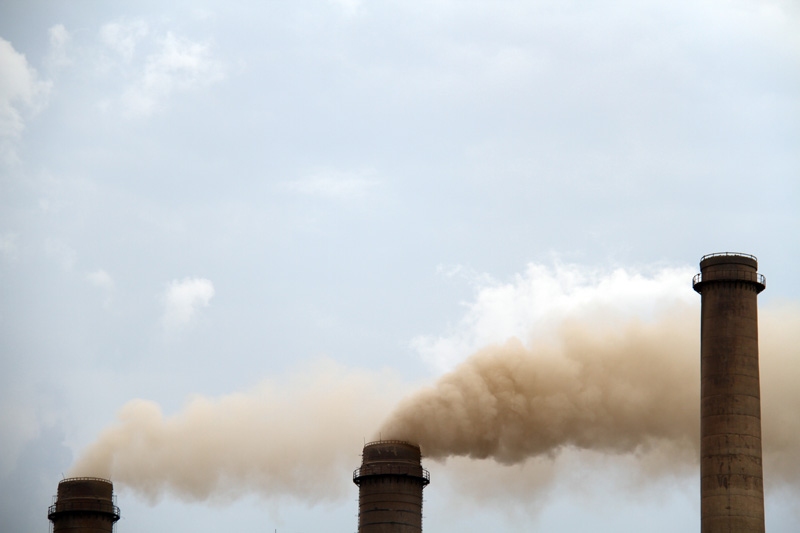
“Preportr”, has obtained some documents which propose building of new energetic capacities in some blocs of Kosova A, as well as total modernization of some of its other blocs. These documents, presented in the form of a Memorandum of Understanding (MoU) and Letter of Interest, speak about the decommissioning and building of new capacities in the basis of units A1 and A2 of TC Kosova A, as well as total modernization of units A3-5.
The proposal for investment in TC Kosova A was put forth by an American-Bulgarian consortium, “Quantum Risk Engineering LLC” - (QRE), consisting of an American foundation, “Quantum Group”, which among other things, also manages parts of “Clinton Foundation”, and the biggest Bulgarian company in the energy field, “Risk Engineering, Ltd”.
But, governmental officials have refused to speak about the consortium of QRE by avoiding questions put by “Preportr”, or by giving insufficient and contradictory information. The EU Office in Kosovo considers shutting down TC Kosova A as the obligation of the Government, and according to this office, investing in this Power Plant “is not economically viable , if at all technically possible”. In the World Bank, there is still hope that the tender for the construction of the power plant “Kosova e Re” will not fail, but if that happens, the director of this institution says there is no plan B for energy supply .
Contrary to the approach of local and international officials, couple of energy experts in Kosovo, which “Preportr” spoke with regarding the proposal of QRE, the rehabilitation of TC Kosova is technically possible, and such ideas should be taken into account by the Government of Kosovo. But, for some, the case of TC Kosova A is already a closed chapter and Kosovo’s energies should be channeled towards constructing new energy capacities in new locations.
Reconstruction – modernization of TC Kosova A
Based on documents obtained by “Preportr”, QRE consortium proposes to the Government of Kosovo the decommissioning of units A1 and A2 and investment in rehabilitation, upgrade, as well as installment of new energy units with an optimal capacity of production of 200 MW, upon the foundation of these two units. Furthermore, this consortium has proposed also the modernization of units A3-5, through reconstruction with the purpose of increasing the net electric capacity to 750 MW. According to the MoU, after all this process, the net capacity of TC Kosova A would be 905 MW.
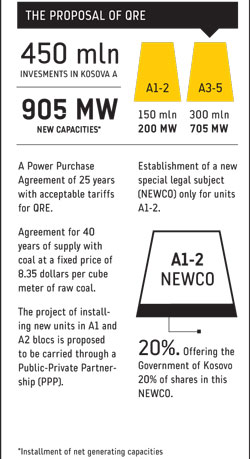 The consortium has planned the establishment of a new local company which would also be a special legal subject for Units A1 and A2, referred in MoU as “NEWCO”. Based on this document, the consortium has proposed the establishment of a new structure of the project for investments, which has been planned to be carried out through “Public-Private Partnership”, and has offered 20% of shares to the Government in this NEWCO, in order that some assets, rights, licenses, concessions and resources, referred to as “assets” currently held by the Government be transferred to NEWCO.
The consortium has planned the establishment of a new local company which would also be a special legal subject for Units A1 and A2, referred in MoU as “NEWCO”. Based on this document, the consortium has proposed the establishment of a new structure of the project for investments, which has been planned to be carried out through “Public-Private Partnership”, and has offered 20% of shares to the Government in this NEWCO, in order that some assets, rights, licenses, concessions and resources, referred to as “assets” currently held by the Government be transferred to NEWCO.
“Preportr” has spoken with representatives of this consortium, and according to them, this investment in TC Kosova A, including the entire project, would be financed by the consortium itself.
Moreover, during the process of upgrade and rehabilitation phase, this Consortium has proposed to provide a bulk amount of energy from import, which is equivalent to 100 MW of the generating capacity in the national network. This proposal, according to MoU, is supposed to minimize the impact of capacity decrease during this renovation phase.
According to this document, the entire process is expected to cost around 150 million euros for units A1 and A2, through PPP, and around 300 million euros for the modernization process of units A3-5. In total, based on the proposal of QRE, the investment is expected to reach the amount of 450 million euros, enabling the generation of 905 MW.
This MoU proposes the signing of a contract (Power Purchase Agreement – PPA), for a length of 25 years, and according to the MoU, this should be done with rates acceptable to QRE. Apart from this, QRE has also asked for a 40-year agreement for supply with coal for units which are under the operation of QRE with a fixed price of 8.35 dollars per dry meteric ton ofcoal.
Moreover, the MoU proposes the transfer of licenses, existing or new, rights and concessions for exploitation of coal mines and production of coal, and provision of this coal in acceptable quantity and quality to the units operated by QRE.
The MoU proposes to the Government of Kosovo to make adequate investments and allocate money for the maintenance of the transmission line of 400 kv with Albania, in order to help the flexibility to export excess energy in Albania and other countries.
With this investment, QRE provides to comply with the EU standards regarding the emission of dust, but also complying with other emission standards.
A planned energy collapse in the horizon
Although the citizens of Kosovo are fortunate to be sitting on top of one of the biggest reserves of lignite in the world with around 12.5 billion tons, out which 10.9 billion usable, for the last 12 years they have not had the chance to have regular and sustainable supply of energy. But this instability of supply may accompany Kosovo citizens at least till 2020.
As co-signer of the Energy Community Treaty, Kosovo is legally bound to shut down TC Kosova A till 2017, losing thus around 1740 GW/h of energy
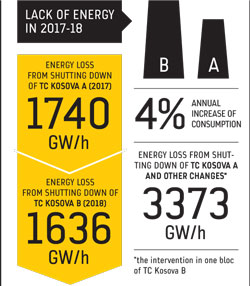 Also, according to plans, an extensive intervention at TC Kosova B is expected to happen in 2018 in order to fulfill the environmental conditions and to improve the efficiency of operation and security. Thus, only from the shutting down of TC Kosova A and the intervention in at least one of the blocs of TC Kosova B, the country will be faced with a base lack of 3375.5 GW/h of electric energy.
Also, according to plans, an extensive intervention at TC Kosova B is expected to happen in 2018 in order to fulfill the environmental conditions and to improve the efficiency of operation and security. Thus, only from the shutting down of TC Kosova A and the intervention in at least one of the blocs of TC Kosova B, the country will be faced with a base lack of 3375.5 GW/h of electric energy.
According to the study of World Bank: Development and assessment of options for supply with electric energy in Kosovo”, based on the preliminary forecast for base needs, it is estimated that the base demand for energy from 2010 to 2015 will increase around 1843 GW/h energy. KEK, on the other side, has told “Preportr” that the energy consumption till 2017 will increase for 640 GW/h.
But, the WB study forecasts that in 2017, Kosovo will need around 7500 GW/h base energy in order to meet domestic needs, a demand which according to this study in 2020 is expected to grow to 8819 GW/h, while in 2025 it is expected to be around 11,588 GW/h energy. According to the Kosovo Statistics Agency , in 2011 the gross production of electric energy in TC’s was 5.621.0 GW/h.
The WB study, which is based on analyzing the balance between supply and demand, shows that in 2017, Kosovo will need around 950 MW of new and sustainable capacities. This demand will grow to 1000 MW till 2019, and at around 1500 MW till 2025.
Furthermore, this forecast regarding the increase of base demand for energy may be called optimistic, since it forecasts the decrease of technical losses from 16.6% in 2010 to 8% in 2025. Similarly, the commercial losses are expected to decrease from 24% in 2013 to 5% in 2018. Otherwise, the base demand for energy could be even higher, depending on the decrease of technical and commercial losses.
These World Bank forecasts on the decrease of technical and commercial losses are actually higher than the conditions set by the Energy and Mines Regulatory Office. According to the conditions of ZRRE, the technical and commercial losses which should be decreased are up to 6% by 2014 plus 5% for following three years after 2014.
If the benchmarks for the decrease of technical and commercial losses are not met, as forecasted by WB but also by ZRRE, the base demand for energy could be higher than the one forecasted by the World Bank, depending on the scale of decrease of these losses.
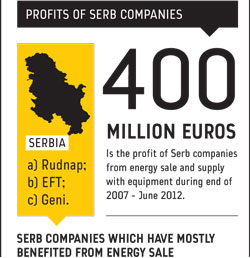 Within a triangle of opportunities, while deciding on alternatives in solving the problem of energy supply at least untill 2020, the country could be faced in taking the toughest solution, having to pay huge amounts of money in purchasing energy.
Within a triangle of opportunities, while deciding on alternatives in solving the problem of energy supply at least untill 2020, the country could be faced in taking the toughest solution, having to pay huge amounts of money in purchasing energy.
On one hand, shutting down TC Kosova A and the repair of TC Kosova B, accompanied by an increase in demand for energy, would indispensably lead to high import. According to information provided by KEK officials regarding a meeting with ZRRE, it is foreseen that during 2013-2017, Kosovo will be spending around 351 million euros in purchasing energy to cover the domestic demand.
According to KEK spokesperson, a similar amount of money, between 300-400 million euros will cost Kosovo in purchasing energy, if TC Kosova A ceases to function in 2017.
Kosovo has been importing energy with a price ranging from 30 to 113 euros per MW/h. If we take the average price of imported energy to be 60 euros per 1 MW/h energy, then only due to shutting down of TC Kosova A and the increase of consumption, which according to KEK will increase to 640 MW/h by 2017, making thus the total amount of lacking energy to 2380 GW/h, then Kosovo will have to spend annually over 140 million euros for energy import. But, if TC Kosova B goes into repair, as plans stand, then Kosovo will be lacking around 4014.5 GW/h, which implies that Kosovo will have to import energy annually up to 240 million euros in order to meet the domestic demand.
This calculation does not take into account the annual demand increase for energy, which according to KEK is around 4%, while the gross increase of demand from 2010 to 2025, according to WB, will be around 4.6%, which would add to the demand for energy, and thus raise the overall cost of import.
Such a big amount of money for import of energy results due to the fact that, according to the most optimistic scenario, TC “Kosova e Re” could begin construction only by 2014. According to the study by World Bank, the time needed for carrying out the transaction, construction of the new Power Plant, and its subsequent release into production could take from 5-6 years, which means that Kosovo cannot have the new power plant before 2020.
But, seeing the continuous changes taking place as concerns plans for the construction of new energy capacities, it is very probable that the current tender for the construction of the new energy plant “Kosova e Re” will fail, and everything that is related to the construction of new capacities will strat from the beginning. This scenario is possible especially after the decision to remove TC Kosova B from the tender package, since this willchange all the parameters of the tendering package. Moreover, the Government is considering the possibility of increasing the capacities of TC “Kosova e Re” , compared to the current project which foresees two blocs of 300 MW.
The possibility that the construction of “Kosova e Re” will fail are 50-50, and if that happens, we have to sit and talk about alternatives. We have no plan B for now
Jan-Peter Olters, director of World Bank for Kosovo
According to the World Bank director for Kosovo, Jan-Peter Olters, the possibility that the current tender on the construction of “Kosova e Re” will fail are 50-50. “The possibility of the construction of TC “Kosova e Re” failing is 50-50, and if that happens, we have to sit and discuss all over again on alternatives. We have no plan B for now”, said WB director to “Preportr”.
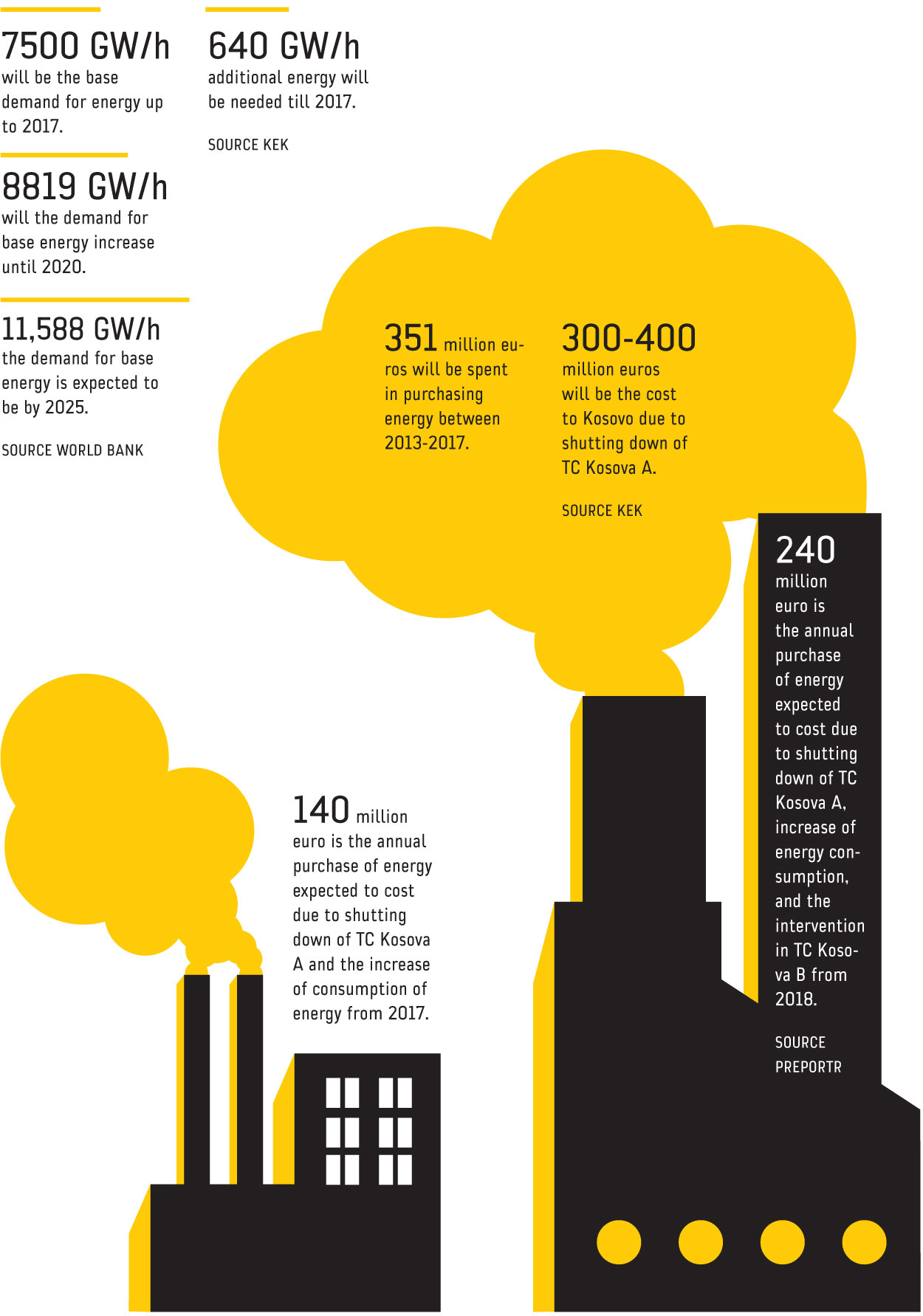
Within this dire scenario, the biggest beneficiaries of this situation will be Serbian companies which export energy to Kosovo. “Preportr” has researched the profits of Serb companies from KEK and has observed that only from the end 2007 to June 2012, Serb companies benefited around 400 million euros from the sale of energy, but also through tenders in supplying with equipment. Serbian companies which have benefited mostly from energy supply are: “Rudnap”, “EFT” and “Geni”, as energy suppliers, and company “IMK 14 Oktobar”, in cooperation with company “Eco Trade” as suppliers. In 2008, only through a tender on the sale and installment of transporting grids, they had benefited more than 49 million euros.. Millions of euros had been invested in these transporting grids, but they broke down continually.
Let’s play ball
According to correspondences obtained by “Preportr”, representatives of QRE consortium were in contact with representatives of the Kosovo institutions for more than 6 months, in order to push forward their proposal to invest in TC Kosova A. Initially, QRE representatives have sent letters and then me with first Dep’t. Prime Minister Behgjet Pacolli, and Dep’t. Prime minister for Economy and Minister of Trade and Industry, Mimoza Kusari-Lila, the Minister for Economic Development, Besim Beqaj, director of KEK, Arben Gjukaj, and director of operation, Nijazi Thaqi. These Government and KEK representatives were presented with a Letter of Interest (addressed to Behgjet Pacolli) and the MoU with specifics regarding their proposal to invest in TC Kosova A.
Representatives of QRE have expressed their discontent to me about the blocade by KEK
Mimoza Kusari Lila, Minister -MTI
The reception of QRE’s proposal by Kosovo institution representatives slid from promising meetings, to a hermetic blockade and total dismissal of the representatives and aims of QRE to invest in TC Kosova A.
Furthermore, based on interviews conducted with Minister Mimoza Kusari-Lila and Minister Besim Beqaj, the proposal of QRE was not reviewed in details and it was never discussed within the Government cabinet. Minister Lila admits to “Preportr” that the representatives of QRE consortium expressed their indignation with the manner they had beenreceived and the treatment of their proposal to invest in TC Kosova A. “Yes, representatives of QRE have expressed their discontent to me about the blockade by KEK and the inability to receive information on TC Kosova A”, said Lila.
From the correspondence between Minister Lila and director of KEK, obtained by “Preportr”, it can be observed that the minister sent KEK a letter through which QRE’s interest is expressed to invest in KEK. But, the return letter, signed by KEK director, Arben Gjukaj says that “KEK appreciates the interest expressed by this company regarding the current and future status of TC Kosova A”. But, according to the letter, the cooperation of KEK with “this company and other companies which could participate in procurement processes regarding TC Kosova A is limited with the right according to the framework of the law on public procurement”, adding that “KEK wishes to ensure equal treatment for all possible bidders as well as provide the same level of access to information and data”, says the return correspondence of KEK director.
QRE’s proposal is outside the scope of KEK’s decision-making
Arben Gjukaj, director of KEK
Director of KEK, Arben Gjukaj admitted meeting with QRE representatives, but he informed them that their proposal is outside the scope of KEK’s decision-making, and that it is the Government which should decide upon that.
The purpose of QRE visiting KEK, as “Preportr” has found out, was to obtain a permission to begin a feasibility study for the purpose of implementing their proposal to invest in TC Kosova A. On date 15 March, 16 energy engineers of QRE came to Kosovo for this purpose. “Preportr” has found that, after the meeting of QRE’s representatives with KEK director, and director of operation, Nijazi Thaqi, the former received a promise that they would have access to KEK for the purposes of a feasibility study. But, after the meeting, QRE representatives had received a phone call by the secretary of KEK director, telling them that it is impossible for QRE representatives to have access to KEK.
But, KEK’s director, Gjuka says that QRE representatives were never given a promise to visit KEK for purposes of a feasibility study, since this KEK does not have the right to do this without a preliminary permission by the shareholder of this company, the Government of Kosovo. Gjukaj says that they never received or saw a MoU regarding a specific proposal of QRE to invest in TC Kosova A. “In a meeting with two QRE representatives, we proposed them to participate in the tender for the re-activation of the bloc A2, but we have not received or seen any other proposal by QRE”.
We have not discussed the proposal by QRE in the ministry, or the government cabinet, since that proposal was illegal
Besim Beqaj, Minister in MED
Minister Lila did not want to comment as to how QRE’s representatives were received by the Minister for Economic Development, Besim Beqaj, suggesting discussing this issue with the minister himself. “Preportr” has carried out a short interview with minister Beqaj, and he confirmed that the proposal of QRE was never discussed, niether by him or the government cabinet, since, according to him, their proposal was totally illegal. “We have not discussed the proposal by QRE in the ministry, or the government cabinet, since that proposal was illegal”, said Beqaj. According to the minister, QRE’s proposal was in violation of the Energy Strategy approved by the Parliament, and was in contradiction with the project for re-activation of bloc A2 by KEK.
Beqaj has refused to respond to the question whether the ministry he heads ever analyzed the content of the proposal of QRE, or whether they have compared this proposal with the project for the construction of TC “Kosova e Re’, as well as the process for the re-activation of bloc A2, in order to see the advantages and disadvantages of each undertakings.
Even Minister Lila, who was herself involved during the entire time when QRE was interested to invest in TC Kosova A, admitted that their proposal, although as such is under the domain of Government and Parliament decision-making, it was never discussed within the cabinet of the Government. Moreover, Lila admitted that the proposal of QRE was not analyzed thoroughly in order to see its advantages and disadvantages, but he simply concluded that “the proposal was good”.
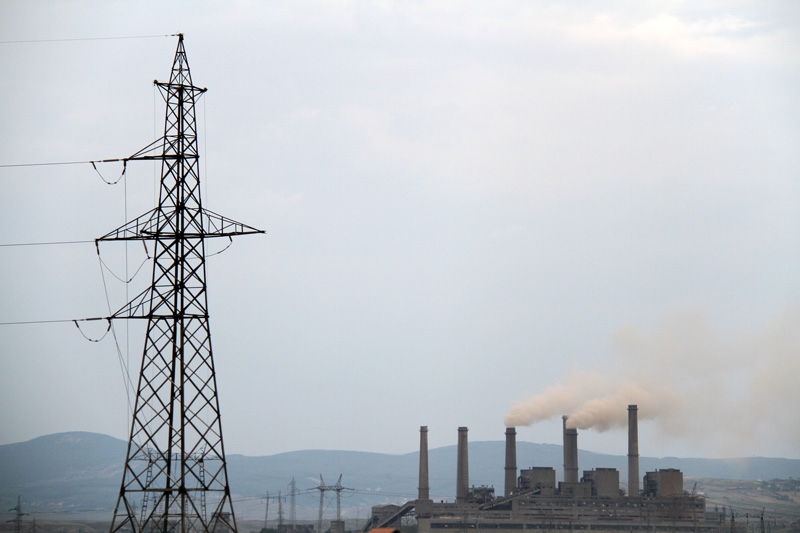
“Preportr” has addressed also the Office of the Prime Minister, in order to see whether the Prime Minister was informed about these meetings between the Government representatives and those of QRE, and whether he is aware of the details of the proposal. Up till now, “Preportr” has not received information from the Office of the Prime Minister on the questions addressed. A similar response came also by the office of the first Deputy Prime minister, Behgjet Pacolli, totally ignoring the request by “Preportr” to respond regarding the meetings with representatives of QRE and their proposal.
Nevertheless, “Preportr” has observed that during the last phase of meetings between QRE and Government representatives, Prime Minister Thaçi, together with first Dep’t. Prime minister Behgjet Pacolli, after a visit in Turkey, came back and met with the Bulgarian Prime minister, Boyko Borisov.
From the statement issued by the Office of the Prime Minister, it can be observed that the meeting was focused on foreign investments ino Kosovo and the economic cooperation between the two countries. But, “Preportr” did not receive an answer whether during the meeting between the two prime ministers the proposal of QRE consortium to invest in TC Kosova A was discussed.
The dinosaur or the new bride!?
TC Kosova A, built by soviets during 1960-70 is considered as one of the biggest environmental polluters in Kosovo, although for a time now not all its capacities are used. Taken together, TC Kosova A and B burn around 7 million tons of coal annually inside a municipality of around 22.000 inhabitants, where 30% of them are considered to have problems with chronic pulmonary diseases.
One of the most sensitive aspects related to the construction of new energetic capacities in Kosovo was the location.
“Preportr” has spoken to some energy experts in Kosovo, and the idea of building new capacities in the foundations of TC Kosova A has split them in two.
Such an investment would imply the use of contaminated surface and the use of an infrastructure which is already in place
Avni Kurshumliu, expert in the field of energy
Avni Kurshumliu, one of the strongest supporters of constructing new capacities on the foundations of TC Kosova A, says that such an investment would have two effects. On one hand, the placement of new energy capacities on the foundations of TC Kosova A would mean the exploitation of a surface already contaminated. According to Kurshumliu, it is much more useful not to build the future capacities on a green surface, but initially use the surface of TC Kosova A. “This would have another advantage because the construction of new capacities on the foundations of TC Kosova A would imply the use of an infrastructure which is already in place”, said Kurshumliu.
According to the overall calculations, it is estimated that the construction of new energy capacities will cost around 1 million euro per 1 MW. This means that the new Power Plant “Kosova e Re”, which according to current plans would have a capacity of 300 + 300 MW, is expected to cost at least 1 billion euro, including here all the infrastructure until its release into function.
On the other hand, QRE’s proposal to invest in TC Kosova A has estimated that the total investment in this TC would be around 450 million euro, but that this investment would make possible installed capacities of 905 MW.
Energy experts, such as Bashkim Gjurgjeala and Avni Kurshumliu admit to “Preportr” that the possibility of constructing new capacities on the foundations of units A1 and A2 is practically possible. Also, they admit that the total modernization of units A3-5 is technically possible, since that technology is present in the market.
Despite the pressure of import, the idea of constructing new capacities on the foundations of TC Kosova A, on a long-term plan, is not beneficial for Kosovo
Luan Shllaku, director of KFOS
On the other hand, Luan Shllaku, director of KFOS is against any idea of constructing new capacities on the foundation of TC Kosova A. According to Shllaku, QRE’s idea has three essential problems. The first, he says, has to do with the location, since TC Kosova A is very close to the capital city and operates within a circle where over 500 thousand people live. The second has to do with the legality of the proposal, being that Kosovo cannot enter into such a relationship with this company. And the third, he says, has to do with Kosovo’s legal commitments as signer of the Energy Community Treaty and the inability to fulfill many of the points coming out of this treaty. “Despite the pressure of import, the idea of constructing new capacities on the foundations of TC Kosova A, on a long-term plan, is not beneficial for Kosovo”, says Shllaku.
Serbia has recently signed a Memorandum of Understanding with the German company RWE for cooperation in the energy sector. This MoU plans the development and improvement of existing power plants, as well as planning, constructing and operation of new power plants. The MoU proposes a period of 9 month-study with the purpose of a full technical and economic evaluation of existing power plants in Serbia. After this phase, a cooperation agreement is to be put in place, specifying the details of the project, and the responsibilities of the strategic partners.
As regards the EU Office in Kosovo, the shutting down of TC Kosova A is a legal obligation, being that Kosovo is a co-signer of the Energy Community Treaty for Southeast Europe. According to this Office, any investment in TC Kosova A according to EU environmental standards would not be “economically viable, if at all technically possible”, the EU Office has said for “Preportr”.
Throughout its entire history since its establishment, the Energy Community Treaty for Southeast Europe has been violated several times by Serbia, but this country has never been penalized so far. The last letter of the Ministry for Economic Development sent to the Secretariat of the Energy Community, requires the inclusion into the discussion agenda of the Ministerial Council the complains of the operator of the electricity transmission system in Kosovo (KOSTT) regarding the failure of Serbia to implement its obligations stemming from the Energy Treaty.
Within a scenario of failing to build new energy capacities by 2020, the country risks going towards energy collapse in 2017. The rigidity and refusal of decision-making factors to consider the most optimal options in solving the problem of sustainable supply with energy at an affordable cost has led the country to permanent dependency on Serb companies for import. This journey of dependency of Kosovo citizens on import from Serb companies may continue further, mainly because domestic politics has never had a claim in strategic decisions in the energy sector.

